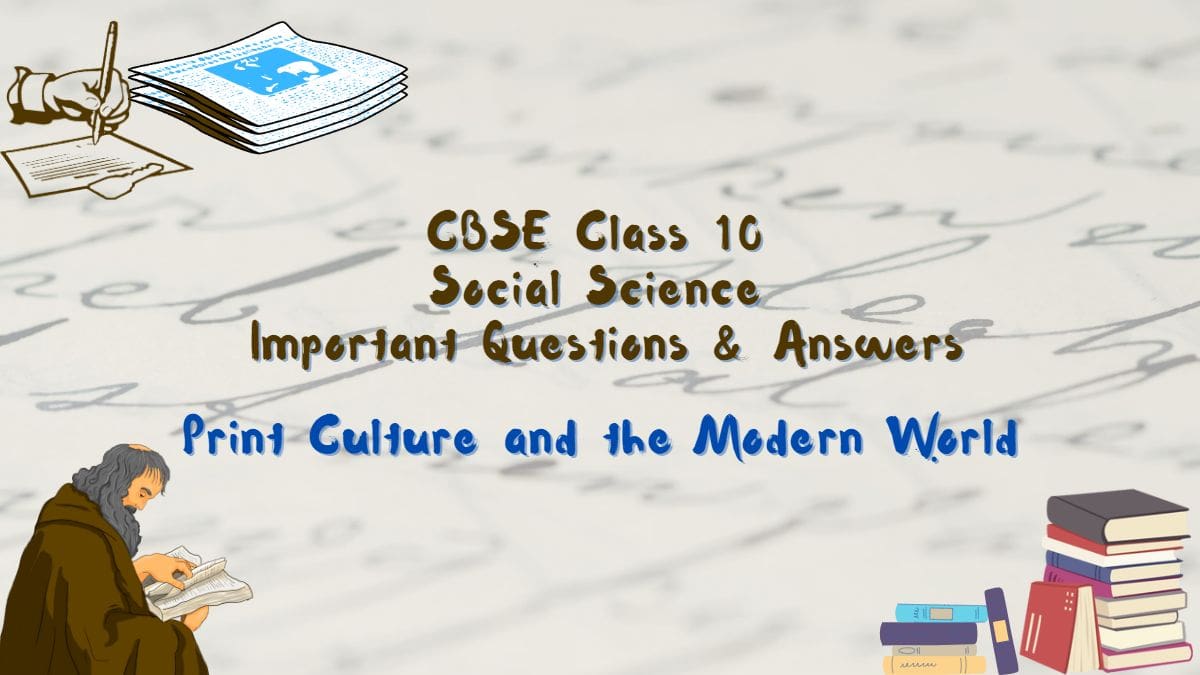CBSE Class 10 Social Science Important Questions: In this article, we would be going through some of the most important multiple choice questions, assertion reason questions and other important subjective questions from the 5th chapter Print culture and the Modern World. These important questions have been prepared by subject experts after careful analysis of the latest NCERT History textbook ‘India and the Contemporary World- II’, the latest syllabus after rationalisation, sample paper for the year 2022-23 and also the previous year papers.
Print culture and the Modern World is the fifth chapter in the 1st unit of CBSE Class 10 Social Science (History) curriculum and it comes under the third section Everyday Life, Culture and Politics
The chapter tries to capture and cover the history of print – the development of print from when it started in East India to its expansion in Europe and in India and the impact on the world and the societies through the coming of print.
To view the complete syllabus of CBSE Class 10 Social Science History Chapter 5, visit CBSE Class 10 Social Science Syllabus 2022-2023.
Please note that since the latest syllabus for CBSE Class 10 Social Science has been rationalised, students must check CBSE Class 10 Social Science DELETED Syllabus 2022-2023 to pay attention to the chapters and topics have been removed and will not be evaluated in the upcoming CBSE Class 10 Social Science Board Examination 2022-23.
CBSE Class 10 Social Science History Chapter 5 Important Questions
MULTIPLE CHOICE QUESTIONS
- A fuller’s job is to
(a) pick up wool
(b) sort wool according to its fibre
(c) gather cloth by pleating
(d) carry wool to the spinner
- What was the reason behind new merchants not set up business in the towns in Europe?
(a) The rules became barrier
(b) Scarcity of product to start any business
(c) The powerful trade guilds and urban crafts made it difficult
(d) None of these
- Who set up the first Indian Jute Mill in Calcutta?
(a) G.D. Birla
(b) Seth Hukumchand
(c) Jamsetjee Nusserwanjee Tata
(d) Dwarkanath Tagore
- When did the export of Indian yarn to China declined?
(a) 1906
(b) 1910
(c) 1915
(d) 1902
- What do you mean by Carding?
(a) In spinning
(b) In weaving
(c) In which cotton or wool fibres are prepared for spinning
(d) In which finishing of cloth is done
- Which of the following countries faced labour shortage in the nineteenth century?
(a) America
(b) Britain
(c) France
(d) Germany
- By late 19th century why did the British manufacturers print calendars for advertisements?
(a) Indian people were fond of using calendars in their houses.
(b) Unlike newspapers and magazines, calendars were used even by people who did not know how to read or write.
(c) It was cheaper to advertise goods through calendars.
(d) It used to add beauty to the room.
- Who produced music book that Dawn of the Century?
(a) New Comen
(b) James Watt
(c) E. T. Paul
(d) None of these
- Why did the weavers suffer from a problem of raw cotton?
(a) The cotton crop perished
(b) Raw cotton exports increased
(c) Local markets shrank
(d) Export market collapsed
- Which War caused new problems for Indian weavers?
(a) The American Civil War
(b) First world war
(c) Second world war
(d) None of these
ASSERTION REASON QUESTIONS
Directions : In the following questions, A statement of Assertion (A) is followed by a statement of Reason (R).
Mark the correct choice as:
(a) Both A and R are true and R is the correct explanation of A
(b) Both A and R are true but, R is not the correct explanation of A
(c) A is true, but R is false
(d) A is false, but R is true
- Assertion (A): When the Spinning Jenny was introduced in the woolen industry, women who survived on hand spinning began opposing new machines.
Reason (R): The fear of unemployment made workers unfriendly to the introduction of new teachnology.
- Assertion (A): The new reading culture was accompanied by a new technology.
Reason (R): From hand printing there was a gradual shift to mechanical printing.
- Assertion (A): By the 1750s, with the arrival of the European companies the Indians started losing their control over the trade.
Reason (R): There was a decline of the old ports like Surat and Hooghly and the emergence of new ports like Bombay and Calcutta.
- Assertion (A): As literacy and school spread in African countries, there was a virtual reading mania.
Reason (R): Primary education became compulsory from the late 19th century.
- Assertion (A): The period of industrialisation before the first factories came up in Europe is termed as proto-industrialisation.
Reason (R): This period was marked by merchants from towns getting products made in villages.
Also visit: CBSE Class 10 Social Science Sample Paper 2022-23
OBJECTIVE TYPE QUESTIONS
- Name the first book published by Johann Gutenberg.
- Who printed the first Tamil book ?
- When did the first printing press come to India?
- _______________ was a German goldsmith and inventor credited with inventing the movable type of printing in Europe.
- Name the countries where the earliest kind of print technology was developed.
- Which city in Europe had the breakthrough of the first printing press?
- A historical account or folk tale in verse, usually sung or recited were called ____________.
- Define Fatwa.
- Who invented the power driven cylindrical press ?
- Name the paper with which Bal Gangadhar Tilak was associated.
- Who said “Printing is the ultimate gift of God and the greatest one ?
- Name the first weekly that appeared in India. Who brought it out ?
All the best!
